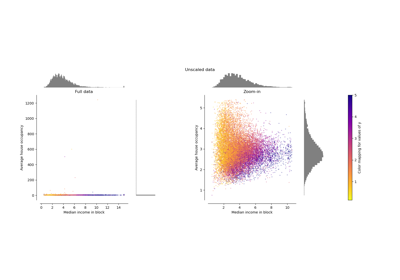MaxAbsScaler#
- class sklearn.preprocessing.MaxAbsScaler(*, copy=True, clip=False)[source]#
Scale each feature by its maximum absolute value.
This estimator scales and translates each feature individually such that the maximal absolute value of each feature in the training set will be 1.0. It does not shift/center the data, and thus does not destroy any sparsity.
This scaler can also be applied to sparse CSR or CSC matrices.
MaxAbsScalerdoesn’t reduce the effect of outliers; it only linearly scales them down. For an example visualization, refer to Compare MaxAbsScaler with other scalers.Added in version 0.17.
- Parameters:
- copybool, default=True
Set to False to perform inplace scaling and avoid a copy (if the input is already a numpy array).
- clipbool, default=False
Set to True to clip transformed values of held-out data to [-1, 1]. Since this parameter will clip values,
inverse_transformmay not be able to restore the original data.Note
Setting
clip=Truedoes not prevent feature drift (a distribution shift between training and test data). The transformed values are clipped to the [-1, 1] range, which helps avoid unintended behavior in models sensitive to out-of-range inputs (e.g. linear models). Use with care, as clipping can distort the distribution of test data.
- Attributes:
- scale_ndarray of shape (n_features,)
Per feature relative scaling of the data.
Added in version 0.17: scale_ attribute.
- max_abs_ndarray of shape (n_features,)
Per feature maximum absolute value.
- n_features_in_int
Number of features seen during fit.
Added in version 0.24.
- feature_names_in_ndarray of shape (
n_features_in_,) Names of features seen during fit. Defined only when
Xhas feature names that are all strings.Added in version 1.0.
- n_samples_seen_int
The number of samples processed by the estimator. Will be reset on new calls to fit, but increments across
partial_fitcalls.
See also
maxabs_scaleEquivalent function without the estimator API.
Notes
NaNs are treated as missing values: disregarded in fit, and maintained in transform.
Examples
>>> from sklearn.preprocessing import MaxAbsScaler >>> X = [[ 1., -1., 2.], ... [ 2., 0., 0.], ... [ 0., 1., -1.]] >>> transformer = MaxAbsScaler().fit(X) >>> transformer MaxAbsScaler() >>> transformer.transform(X) array([[ 0.5, -1. , 1. ], [ 1. , 0. , 0. ], [ 0. , 1. , -0.5]])
- fit(X, y=None)[source]#
Compute the maximum absolute value to be used for later scaling.
- Parameters:
- X{array-like, sparse matrix} of shape (n_samples, n_features)
The data used to compute the per-feature minimum and maximum used for later scaling along the features axis.
- yNone
Ignored.
- Returns:
- selfobject
Fitted scaler.
- fit_transform(X, y=None, **fit_params)[source]#
Fit to data, then transform it.
Fits transformer to
Xandywith optional parametersfit_paramsand returns a transformed version ofX.- Parameters:
- Xarray-like of shape (n_samples, n_features)
Input samples.
- yarray-like of shape (n_samples,) or (n_samples, n_outputs), default=None
Target values (None for unsupervised transformations).
- **fit_paramsdict
Additional fit parameters. Pass only if the estimator accepts additional params in its
fitmethod.
- Returns:
- X_newndarray array of shape (n_samples, n_features_new)
Transformed array.
- get_feature_names_out(input_features=None)[source]#
Get output feature names for transformation.
- Parameters:
- input_featuresarray-like of str or None, default=None
Input features.
If
input_featuresisNone, thenfeature_names_in_is used as feature names in. Iffeature_names_in_is not defined, then the following input feature names are generated:["x0", "x1", ..., "x(n_features_in_ - 1)"].If
input_featuresis an array-like, theninput_featuresmust matchfeature_names_in_iffeature_names_in_is defined.
- Returns:
- feature_names_outndarray of str objects
Same as input features.
- get_metadata_routing()[source]#
Get metadata routing of this object.
Please check User Guide on how the routing mechanism works.
- Returns:
- routingMetadataRequest
A
MetadataRequestencapsulating routing information.
- get_params(deep=True)[source]#
Get parameters for this estimator.
- Parameters:
- deepbool, default=True
If True, will return the parameters for this estimator and contained subobjects that are estimators.
- Returns:
- paramsdict
Parameter names mapped to their values.
- inverse_transform(X)[source]#
Scale back the data to the original representation.
- Parameters:
- X{array-like, sparse matrix} of shape (n_samples, n_features)
The data that should be transformed back.
- Returns:
- X_original{ndarray, sparse matrix} of shape (n_samples, n_features)
Transformed array.
- partial_fit(X, y=None)[source]#
Online computation of max absolute value of X for later scaling.
All of X is processed as a single batch. This is intended for cases when
fitis not feasible due to very large number ofn_samplesor because X is read from a continuous stream.- Parameters:
- X{array-like, sparse matrix} of shape (n_samples, n_features)
The data used to compute the mean and standard deviation used for later scaling along the features axis.
- yNone
Ignored.
- Returns:
- selfobject
Fitted scaler.
- set_output(*, transform=None)[source]#
Set output container.
See Introducing the set_output API for an example on how to use the API.
- Parameters:
- transform{“default”, “pandas”, “polars”}, default=None
Configure output of
transformandfit_transform."default": Default output format of a transformer"pandas": DataFrame output"polars": Polars outputNone: Transform configuration is unchanged
Added in version 1.4:
"polars"option was added.
- Returns:
- selfestimator instance
Estimator instance.
- set_params(**params)[source]#
Set the parameters of this estimator.
The method works on simple estimators as well as on nested objects (such as
Pipeline). The latter have parameters of the form<component>__<parameter>so that it’s possible to update each component of a nested object.- Parameters:
- **paramsdict
Estimator parameters.
- Returns:
- selfestimator instance
Estimator instance.
Gallery examples#

Compare the effect of different scalers on data with outliers